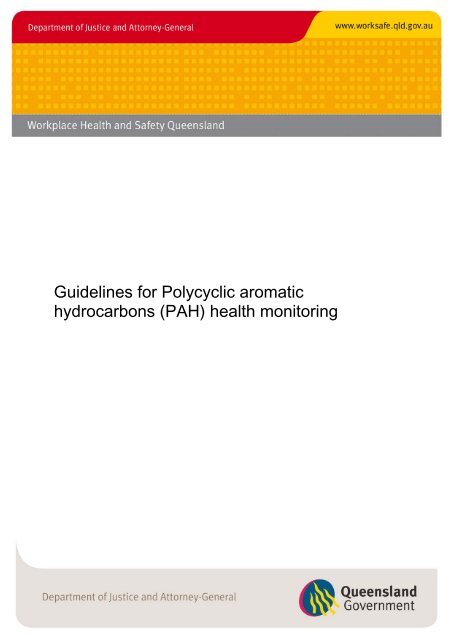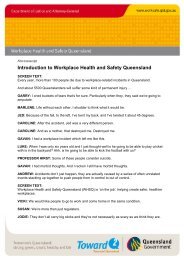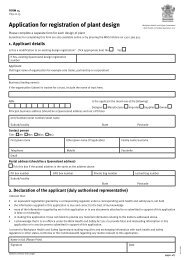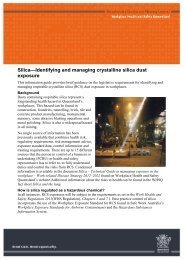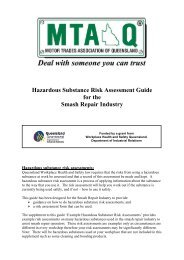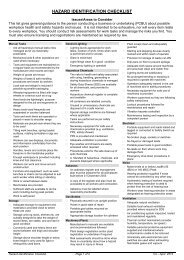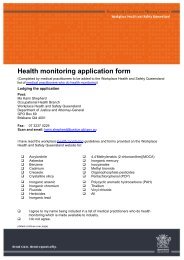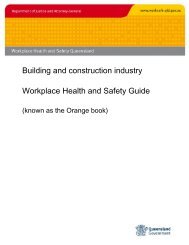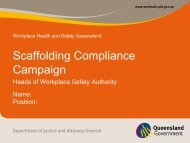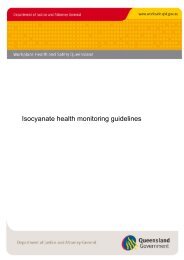(PAH) health monitoring guidelines - Queensland Government
(PAH) health monitoring guidelines - Queensland Government
(PAH) health monitoring guidelines - Queensland Government
Create successful ePaper yourself
Turn your PDF publications into a flip-book with our unique Google optimized e-Paper software.
Guidelines for Polycyclic aromatichydrocarbons (<strong>PAH</strong>) <strong>health</strong> <strong>monitoring</strong>
Polycyclic aromatic hydrocarbons (<strong>PAH</strong>) <strong>health</strong><strong>monitoring</strong>Substance:Polycyclic aromatic hydrocarbons (<strong>PAH</strong>)Chemical formula: Polycyclic aromatic hydrocarbons are a large class of organiccompounds containing two or more fused aromatic rings made up of carbon and hydrogenatoms.Exposure standard: There are more than 100 different <strong>PAH</strong>s - generally they occuras complex mixtures. There are no current exposure standards except for naphthalene(52mg/m 3 = 10 ppm). TWA exposures should be controlled to the lowest practicable level.Sweden and German Limit benzo (a) pyrene 2 µg/m 3Main uses/occupations at riskUse of polycyclic aromatic hydrocarbons and means of industrial exposureIndustry Occupation How used Route ofexposureAluminiumsmelterPetroleumrefineryBitumenprocessing/roadpavingSteel MillsCarbon anode plantoperatorMaintenance worker,refinery worker,coke oven workerAnode and cathodemanufacturing processExtraction andrefining operationsInhalationDermalIngestionInhalationDermalIngestionRoad worker Road construction InhalationDermalIngestionCoke Oven workerMaintenance workerBy production offugitive emissionsSteel plant and foundry workers may also be exposed to <strong>PAH</strong>s.InhalationPolycyclic aromatic hydrocarbons are annulated benzene ring compounds formed fromincomplete combustion of organic matter and are ubiquitous environmental contaminants.Some <strong>PAH</strong>s are manufactured as individual compounds for research purposes, in medicinesand to make dyes, plastics and pesticides.Non-occupational sources<strong>PAH</strong>s are released during incomplete combustion of coal, oil and gas, garbage, or otherorganic substances like tobacco or charbroiled meat. They are found throughout theenvironment in the air, water and soil.Exposure occurs by breathing air containing <strong>PAH</strong>s from cigarette smoke, wood smoke,vehicle exhausts, agricultural burn smoke. Exposure can also occur by eating grilled orcharred meats, contaminated cereals, flour, bread, vegetables, fruits or meats and drinkingcontaminated water.Psoriasis patients treated with coal-tar are also exposed to <strong>PAH</strong>.Workplace Health and Safety <strong>Queensland</strong>, Department of Justice and Attorney-GeneralPolycyclic aromatic hydrocarbons (<strong>PAH</strong>) <strong>health</strong> <strong>monitoring</strong> <strong>guidelines</strong>PN10470 Version 2. Last updated June 2012.
Target organ/effectThere is evidence that workers exposed to high airborne levels of some <strong>PAH</strong>s show increasedrisk of lung, kidney, bladder, gastrointestinal and skin cancers.Photosensitivity of skin.Type of <strong>health</strong> <strong>monitoring</strong> required Demographic, medical and occupational history. Physical examination only if indicated by occupational and medical history. Urinary 1-hydroxypyreneFrequency of surveillance at baseline during exposure if any excessive exposure at termination.Biological occupational exposure levels (BOEL)The assessment of occupational exposure is difficult because workers are exposed to amixture of compounds. Airborne levels of benzene-soluble fraction fails to take into accountthe potential pathway of skin absorption, which can contribute significantly to the totalinternal dose. The most widely used marker is 1-hydroxypyrene (1-HP) in human urine and ametabolite of pyrene. The levels of 1-hydroxypyrene in the urine increase during the courseof a work day, reaching maximum values three to nine hours after the end of work. If thecontribution of dermal exposure is important, postshift 1-hydroxypyrene excretion can belower than preshift levels when the worker has been exposed to <strong>PAH</strong> on the day prior tosampling. The difference between beginning and end of work week excretion gives anindication of the average exposure over the work week.ACGIH conclude that data are not sufficient to justify a numerical Biological ExposureLimit scientifically based on <strong>health</strong> outcome however, make the following recommendations.Nonsmokers in the unexposed population will generally have 1-HP values < 0.3 µg/LMedian for non-exposed smokers 0.5 µg/LBenchmark value urine 1-HP 1 µg/L is evidence of occupational exposure and it issuggested to control exposures towards the levels seen in the general population.Conversion1 µg 1-hydoxypyrene /L = 1.4 μmol 1-hydoxypyrene/mol creatinineThe Health and Safety Executive (HSE) in the UK have set a Benchmark Guidance Valuefor <strong>PAH</strong>s at 4 μmol 1-hydoxypyrene/mol creatinine in urine measured at the end of ashift. 1Note: A benchmark guidance value is a hygiene-based guidance value, set at a level where90% of available validated data, provided by a cross-sectional study of workplaces with goodoccupational hygiene practices, are below the value. It can therefore be achieved by the greatmajority of industrial premises which employ good workplace practices.1 Health and Safety Executive www.hse.gov.ukWorkplace Health and Safety <strong>Queensland</strong>, Department of Justice and Attorney-GeneralPolycyclic aromatic hydrocarbons (<strong>PAH</strong>) <strong>health</strong> <strong>monitoring</strong> <strong>guidelines</strong>PN10470 Version 2. Last updated June 2012.
Absorption/excretion pharmacology 2Polycyclic aromatic hydrocarbons are formed when natural or synthetic organic materials areburnt in the presence of less than ideal oxygen levels. <strong>PAH</strong>s are organic compoundscomprising a mixture of aromatic hydrocarbons ranging from the 2-ring naphthalene throughto the higher 6- and 7-ring molecular compounds.Intake may occur through the lungs, skin and gastrointestinal tract. Studies in occupationallyexposed workers suggest that the half-life for urinary 1-hydroxypyrene excretion is about 18hours. 3The assessment of occupational exposure is difficult because workers are exposed to amixture of compounds with similar physical and chemical properties and including severalpotential carcinogens. A practical approach to the problems of assessing <strong>PAH</strong> requires theuse of a marker, such as a major metabolite, or a <strong>PAH</strong> representative of this class ofcompounds. The most widely used marker is 1-hydroxypyrene-O-glucuronide (1-OHP-gluc),the major form of 1-OHP in human urine and a metabolite of pyrene. In non-occupationallyexposed subjects, 1-hydoxypyrene excretion is significantly higher in smokers than in nonsmokers.In occupationally exposed subjects, smoking appears to be a minor confounder.It has been proposed that the biologically effective dose of <strong>PAH</strong> can be evaluated by themeasurement of the binding of <strong>PAH</strong> electrophilic metabolites to DNA in nucleated bloodcells and blood proteins (haemoglobin, albumin). More data are necessary to establish thevalue of these biological markers for exposure and risk assessment.Summary of toxicologyAcute effectsThe systemic effects of naphthalene (moth-repellent) are known from numerous cases ofaccidental intake, particularly by children. The typical effect after dermal or oral exposure isacute haemolytic anaemia. The lethal oral dose is 5000 to 15 000 mg for adults and 2000 mgtaken over two days for a child.Chronic effectsTobacco smoking is the most important single factor in the induction of lung tumours andalso for increased incidences of tumours of the urinary bladder, renal pelvis, mouth, pharynx,larynx and oesophagus. Occupational exposure to soot as a cause of scrotal cancer was notedfor the first time in 1775. Later, occupational exposure to tars and paraffin was reported toinduce skin cancer. The lung is now the main site of <strong>PAH</strong>-induced cancer, whereas skintumours have become rarer because of better personal hygiene.Summary of epidemiologyThe first report of cancer from an occupationally-related chemical exposure was connected to<strong>PAH</strong> exposure. Percival Pott first observed in 1775 that there was a high incidence of scrotalcancer in London chimney sweeps and attributed it to soot and coal tar collecting in skinfolds 4 .2 Lauwerys et al, op cit.3 Buchet, J.P. at al. Evaluation of exposure to polycylic aromatic hydrocarbons in a coke production and a graphiteelectrode manufacturing plant: assessment of urinary excretion of 1-hydroxypyrene as a biological indicator of exposure.Br. J. Ind.Med; 1992. 49:761-768.4 Brown JR, Thornton JL. Percival Pott (1714 -1788) and chimney sweeper cancer of the colon.Br.J.Ind.Med;1957.14(1):68-70.Workplace Health and Safety <strong>Queensland</strong>, Department of Justice and Attorney-GeneralPolycyclic aromatic hydrocarbons (<strong>PAH</strong>) <strong>health</strong> <strong>monitoring</strong> <strong>guidelines</strong>PN10470 Version 2. Last updated June 2012.
Benzo(a)pyrene, benzo(a)anthracene and dibenzo(a,h)anthracene are classified according tothe GHS as Carcinogen Category 1B (may cause cancer).Epidemiologic studies have been conducted of workers exposed at coke ovens during coalcoking and coal gasification, at asphalt works, foundries, and aluminium smelters andworkers exposed to diesel exhaust. Increased lung tumour rates due to exposure to <strong>PAH</strong> havebeen found in coke oven workers, asphalt workers and workers in pot rooms of aluminiumreduction plants. The highest risk was found for coke oven workers, with a standardisedmortality ratio of 195. 5Further information/referencesInternational Program for Chemical Safety. Polycyclic aromatic hydrocarbons, selected nonheterocyclic.Environmental Health Criteria 202. 1998. www.inchem.orgAgency for Toxic Substances and Disease Registry. Toxicological profile polycyclic aromatichydrocarbons. See www.atsdr.cdc.gov/toxprofiles/tp69.html© The State of <strong>Queensland</strong> (Department of Justice and Attorney-General) 2011Copyright protects this document. The State of <strong>Queensland</strong> has no objection to this material being reproduced, but asserts its right to berecognised as author of the original material and the right to have the material unaltered.The material presented in this publication is distributed by the <strong>Queensland</strong> <strong>Government</strong> as an information source only. The State of <strong>Queensland</strong>makes no statements, representations, or warranties about the accuracy or completeness of the information contained in this publication, and thereader should not rely on it. The <strong>Queensland</strong> <strong>Government</strong> disclaims all responsibility and all liability (including, without limitation, liability innegligence) for all expenses, losses, damages and costs you might incur as a result of the information being inaccurate or incomplete in any way,and for any reason.5 Environmental Health Criteria 202, 1998 www.inchem.orgWorkplace Health and Safety <strong>Queensland</strong>, Department of Justice and Attorney-GeneralPolycyclic aromatic hydrocarbons (<strong>PAH</strong>) <strong>health</strong> <strong>monitoring</strong> <strong>guidelines</strong>PN10470 Version 2. Last updated June 2012.


